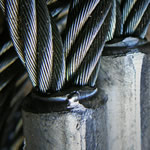HOME >> Slings

SLINGS
Safety Measures while using the Wire Rope Sling
- Before taking up the wire rope sling for lifting the material, visual inspection is an important factor to make sure that the wires of the slings are not rusty and there are no broken wires /damaged wires. Make sure that you have measured the weight to be lifted and the distance to move the object and up to what height the material is to be lifted. Confirm the capacity of the sling i.e. safe working load including the capacity of sling leg angles and physical parameters of the load.
- Make sure that the lifting hook is having the required capacity and how to attach the sling to the object of lifting.
- Choose the right sling considering the capacity of end fittings such as ferrules, hitch and other fittings involved which should be of right type for the lifting application. In other words all the end fittings of the slings such as ferrule, hooks, thimbles, etc, should have adequate capacity as the capacity of such items are different. If D/d ratios are smaller than those indicated the sling’s rated capacity must be reduced. Make sure that the pad, all corners in contact with the sling to minimize the damage to the sling.
- While using the sling follow strictly the guidelines as laid down in ASME regulations. Since the length of the sling cannot be changed, select the appropriate length of the sling based on the capacity of the object to be lifted.
- Make sure that the sling is first attached to the object to be lifted and then attach it to the hook.
- To prevent and avoid the slippage while using the sling, always place the eye or link in the base bowl of the hook. This will prevent the point loading on the hook. The sling’s legs should contain and support the load from the sides above the centre of gravity when using a basket hitch. Make sure the length of the sling is adequate to match with the rated capacity while considering the angle of the legs.
- Before lifting the object, tug lightly on the rigging to make sure that blocking, sling and load protection are in place, and then lift slightly off the ground and recheck the assembly.
- To be on the safer side move away from the areas between the sling and the object to be lifted and the crane hook or hoist hook. Make sure that swinging or movement of the lifting object is avoided. It will be better to use a tagline or tether while lifting the object and moving the object to the distance.
- The object to be lifted very slowly and sudden jerk must be avoided. This will apply while unloading the object or keeping the object on the surface. Always see that sudden lifting and swinging of the load is avoided.
- After the lifting & shifting is over remove the sling from the object of the lifting and have a thorough check up f the sling for the possible damage of the wire rope, end fittings, etc. If the slightest damage is noticed do not hesitate to discard and destroy the sling immediately and do not store the damage sling in the rag until you are next lift.
